Women on film competition
Entrants’ inspirations, part six:
Films (and a cinema)
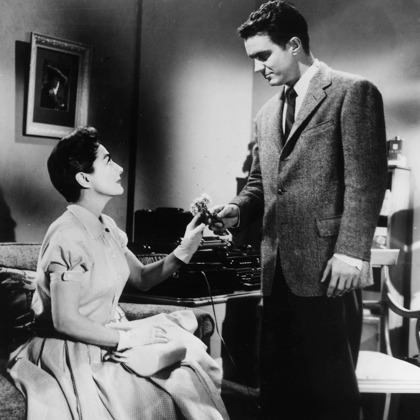
Joan Crawford in Robert Aldrich’s 1956 Autumn Leaves
All the competition entries fit to print!
Earlier this year we held a competition for amateur female film writers, inviting them to submit a thumbnail description of a person in the world of film who is or has been an inspiration to them.
We had a terrific response – 107 entries came in, of cheeringly high general calibre and broad range – and a shortlist is now being picked over by our judging panel.
In the meantime we’re now beginning to edit and publish the best of the postbag, split into subject categories: following this page of entries about actors, we’ll be uploading submissions about directors, other off-camera crafts people, film characters and films. Check back soon for those, or follow us on Twitter or Facebook to stay informed.
» See our other entrants’ inspirations:
Actors | Directors A-H | Directors K-W | Other crew, collaborators, and critics | Characters
» See our critics’ inspirations
» See our competition introduction
Emily Ryan, Irvine, California, USA
One of my film inspirations is Robert Aldrich’s Autumn Leaves (1956, above). It brought to life one of my favourite characters, the hopeless and middle-aged Millicent Wetherby, who carries a monogrammed handbag and dreams of chicken salad at a deserted diner. This bizarre woman, played by a 51-year-old Joan Crawford, is a fantastic creation. At the beginning of the film, we understand that she has been enduring a solitary business and social career: she’s a typist who trades in a pair of symphony tickets at the box office for a pricier seat for one.
Life begins when she reluctantly agrees to share her booth with Cliff Robertson’s Burt Hansen. Aldrich sets her up the most tarnishing sort of defeat at the hands of this younger manipulator. Crawford’s portrayal of the naïve Millicent is expert and intriguing, her legendary silhouette somehow wrenched into plainness. She offers an arsenal of self-conscious traits, which includes a girlish, manic pronunciation of “Okay!” as Burt loutishly suggests they go Dutch. We soon stop seeing Joan and start recognising Millicent, a mature woman who makes missteps in the search for love.
Aldrich has been described as having a penchant toward the psychotic and physically unkempt, but his decision to pair well-known actresses with peculiar or fringe material has yielded legendary performances. In Hush, Hush, Sweet Charlotte (1964) and The Killing of Sister George (1968) he presents grotesque scenes of jealousy, aging and desire. Setting aside his well-known high camp, epic action and comedy hits, Aldrich’s story of solitude is still my favorite theme. In the face of these gruesome Technicolor heroines in their overly powdered skin and paper-mache eyelashes, we have the monochrome Millicent, emerging from the cabana: all neck and legs, stripped of her protective shadow.
Here, Aldrich captures the erstwhile Queen of Hollywood in a skilled portrait of anonymity.
Nancy Hogg, Cambridge, UK
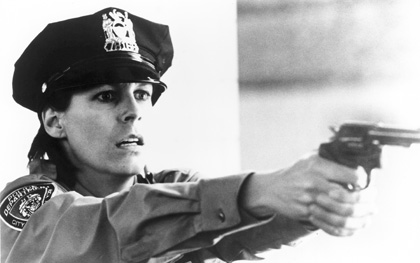
“Blue Steel: A Point Blank Thriller” is how low voiceover man announced this 1989 outing for Jamie Lee Curtis. In the trailer for Katherine Bigelow’s film we were informed that “the man by her side couldn’t save her and the man in her arms was the killer”. Feminist theory aside, this isn’t the best position to be in. But what would in many a director’s hands have been a join-the-dots cop thriller and an exercise in gun fetishism became, under Bigelow’s direction, both these things and a great deal more.
Thrillers and horror films in the 1980s were often a game of It featuring middle-aged men in sweaty vests and nubile women in wet t-shirts. But the men held the guns. And even if a woman was allowed to hold a gun, her presumedly strangely misshapen hands meant she usually had to hold it in both hands to fire it.
But Officer Turner is “no ordinary cop”. Indeed not, mostly because she is a woman – and of course helplessly beautiful and foolish in her romantic choices. But when, on her first day in uniform, a bungled robbery plunges her into a protracted duel with a psychotic and obsessive man, what follows is a gripping thriller.
Arguably, Blue Steel involves replacing the male with a female lead in what’s a male-dominated genre. But how many gun-toting male police officers do we actually know? Isn’t the genre based on shared fantasy anyway? If so, why not let Jamie Lee have a go?And why, just because she is a woman, should she do the morally good thing at the end of the film? Instead, in a striking and memorable moment, she rises from the smoke of a shootout to kill the now unarmed killer. Not only that, she even manages to fire the gun with one hand.
Julie Katherine Praetzel, New York, USA
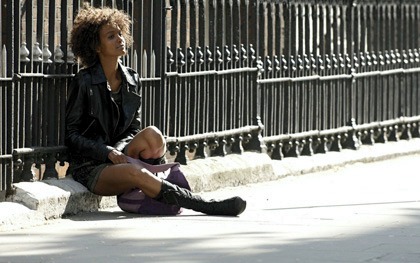
The recent film Desert Flower (2009) by German director Sherry Horman, based on the life of Waris Dirie, was marketed as a sort of Cinderella tale of a young Somalian woman working as a lowly London cleaner who’s discovered by an aging fashion photographer and transformed into a supermodel. (She’s authentically portrayed by supermodel Liya Kebede.) Unlike Cinderella, whose only friend was a fleeting fairy godmother, the young Waris’s real transformation occurs through her nurturing friendship with aspiring dancer Marilyn (dynamically played by Sally Hawkins).
Theirs is not the superficial, Sex and the City dynamic – shopping for shoes and bitching about Mr. Big – so pervasive in representations of female friendship. The two women share what may be the most intimate moment in cinematic history: revealing their vaginas to one another. The moment is revolutionary; they are not exposing their bodies to give one another sexual pleasure or for the sexual pleasure of a watching man, as is almost exclusively the case in film. The scene is emotionally, rather than sexually, charged. Two women from dramatically different cultures – one which removes all potential for sexual arousal from a woman’s body through painful circumcision, the other in which women are sexually liberated – share their private parts to connect on a deeper level. It is through this exchange that Marilyn is able to understand and help heal Waris’s pain. The scene is an intimate and moving moment, one women are often denied in film and life.
Marilyn’s loving and empathetic gaze is a weighted contrast to the gaze of the grubby male photographer who views Waris’s body as a money-making tool to be sold for mass consumption. The photographer-model relationship mirrors the treatment of the female body by film directors.
This powerful scene chips away at that paradigm as it suggests the depth of human emotions that can be explored through the naked female body, and its ability to arouse more responses than an erection.
Alison More, Nijmegen, The Netherlands
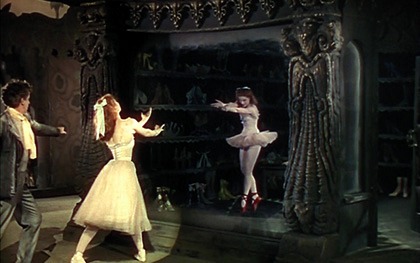
Like generations of would-be ballerinas, I came to appreciate film through The Red Shoes (1947), directed by Michael Powell and Emeric Pressburger. Though originally captivated by its dance scenes, I soon realised that, like many of Powell’s films, the film contained layers of meaning, in this case concerning the struggle to separate art and love.
The Red Shoes depicts a young dancer, Vicky Page (played by Moira Shearer), who falls in love, both with a composer and with her art. Although the original script was simply a romance, Powell added an additional layer of narrative by insisting that a ballet be choreographed for his film, depicting a young woman condemned to dance to her death by a pair of enchanted shoes.
The dilemma of being caught between two worlds runs throughout Powell’s work: Black Narcissus (1947) portrays nuns torn between the physical and the spiritual, and The Edge of the World (1937) Shetland islanders who are at once tormented and completed by the landscape they inhabit.
Though the dialogue in The Red Shoes is important, words play a secondary role to images. Instead Powell uses unconventional camera angles to capture Page dancing amidst swirling ephemeral and paper creatures. Dancer, dancing and dance combine to reveal Page’s anguish. At the same time, her passion and torment are enhanced through the prominence of the colour red, which represents both passion and sacrifice.
Megan Felicity James
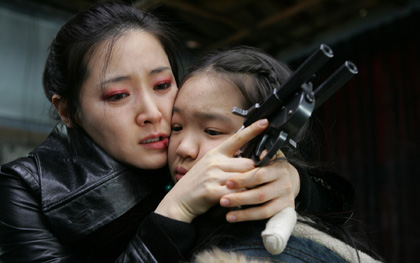
Stuck on my bedroom wall is one of my most valued possessions. It is a film poster bearing the iconic image of a woman, a halo circling her tear-stained face. This poster is for Lady Vengeance (2005), by South Korean writer-director Park Chan-wook, and the film is my greatest cinematic inspiration, as well as my constant critical benchmark.
Lady Vengeance forms the final part of a trilogy that began in 2002 with Sympathy for Mr Vengeance (2001), followed by the globally acclaimed Oldboy (2004). Championed by Quentin Tarantino at Cannes, Oldboy’s breathtaking gore-fest eclipsed the later reception of Lady Vengeance, Park’s more striking and accomplished work.
Lee Geum-ja, the film’s vengeful leading lady, is freed after 13 years in prison for a child’s murder. She swiftly snaps into action to track down the man who framed her.
I first watched Lady Vengeance in a stuffy Cardiff cinema, where I formed half of the total audience. Park’s work felt like it was somehow made for only me, its sole spectator. If more female filmgoers could be provoked by a similar personal encounter, perhaps we could in time become more than a third of film critics.
The chilling baroque score; the signature slashes of Geum-ja’s pink eyeshadow; surreal messages spelt out by clouds over an Australian desert; a motif of white tofu and Catholic forgiveness… This beautifully brutal film is woven together with a fine, darkly comic thread, and cannot be stuffed in a box along with many other titles crudely marked ‘Asia Extreme.’On my film poster, Lady Vengeance herself fiercely returns my gaze, and challenges me to search for new critical perspectives, whilst daring me to discover more.
Oonagh Kearney, London, UK
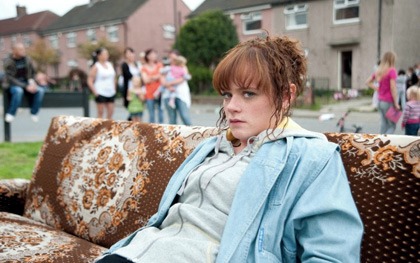
Motherhood is complex. In any given culture, a number of unspoken rules guide what a mother is expected or permitted to say, do and think. When these rules are broken, we become alarmed, surprised and excited; we pause, listen, ask ourselves questions. This is the intellectual power of cinema: to awaken.
Last year, Clio Bernard’s The Arbor left me speechless with compassion for anyone caught in the crossfire between the competing calls to motherhood, creativity and abuse. Andrea Dunbar died tragically at the age of 29 in her local pub. She was a playwright of precocious talent. She had three children with three different men. Why, nine months later, does her story still sear my mind?Like literature and painting, film is constantly seeking new ways to tell the truth. Bernard’s decision to hire actors to lip-synch, word for word, the audio recordings she made with Dunbar’s family and friends is unexpectedly powerful. Every turn of phrase and emotional hesitation brings us intimately closer to their lived experiences. And yet – although these testimonies vibrate with authenticity – their visual presentation is a fiction.
Apart from the success of this strangely affecting technique, Bernard’s approach pays off in other ways: she protects the visual identity of Dunbar’s family and friends, she draws attention to the skill of the actors, and she allows the audience to feel less voyeuristic. Given the sensitivity of the events covered, including the death of a baby through maternal negligence, this negation of our gaze becomes an act of generosity. We listen and watch, and although our minds bring the two experiences together, we know they are not one.
If cinema is devoted to the act of looking, Bernard questions this process by asking us to look, adjust and listen again. If we want a cinema that is real, she tells us to open our toolbox and play. By experimenting, taking risks and following her own inner compass, her debut feature testifies to the power of the human voice, however haunting the tale.
Rebecca Brand, London, UK
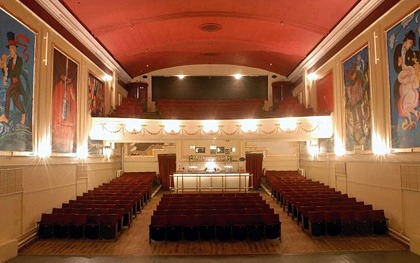
Some may say that a building doesn’t count as a “person in the world of cinema”, but I beg to differ. The environment in which we view a film is just as important to our overall experience as any individual auteur or movie star, and can be a memorable character in itself.
That’s certainly true of the Electric Palace cinema, which popped up in the run-down seaside town of Hastings when I was a teenager. It was Tardis-like: one would enter through an inconspicuous doorway illuminated by kitsch fairy lights and ascend a flight of rickety stairs to find 40 flea-bitten, red velvet seats worshipping up to the screen. The digital projection was crass and prone to glitches, and seagulls could be heard squawking on the rooftop. But that was all part of the charm, and anything from Battleship Potemkin (1925) to sing-a-long The Sound of Music (1965) would grace the screen in a given week. It became like a best friend, a comfortable companion with whom I shared my formative filmic experiences.
Sadly, independent cinemas are few and far between and struggle to survive where they do exist. For so many outside of urban hubs and their cultural spoils, the local multiplex remains their sole, soulless source of cinema. Void of individuality, it could be in any town in any part of the UK providing the same experience.
The arrival of the Electric Palace in Hastings showed me that film is as much about the joy of cinema-going – the seat, the smell, the seagulls squawking – as it is about the gems that await on screen. And more than any one performer or filmmaker I was introduced to within those four walls, the cinema itself stood out as the greatest character of all.
Thanks also to Marina Georgieve Uzunova (whose gaze was humbled by José Luis Guerín’s In the City of Sylvia), Antoniya Pektova (who hailed the purity of Michael Dudok de Wit’s Father and Daughter), Darya Antonovna Papko (who hailed the distinctive language of Joanna Hogg’s Archipelago), Camilla Sheather-Neumann (who gave thanks for the playfulness of Jean-Luc Godard’s Breathless) and Kim van Honk (who is uplifted by a good spaghetti western).
See also
Forgotten pleasures of the multiplex, pt 1: Films A-D: including Robert Aldrich’s All the Marbles (May 2011)
The Hurt Locker reviewed by Guy Westwell (September 2009)
Venice, part one: Jonathan Romney’s report from the Venice Film Festival, including a viewing of Desert Flower (September 2009)
Seeing red: Ian Christie on the restoration of The Red Shoes (August 2009)
Park Chan-wook interviewed by Ali Jafaar (February 2006)
Women on film: critics’ inspiration including Anna Smith on The Arbor (April 2011)
